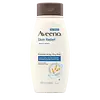What's inside
What's inside
 Key Ingredients
Key Ingredients

 Benefits
Benefits

 Concerns
Concerns

 Ingredients Side-by-side
Ingredients Side-by-side

Water
Skin ConditioningGlycerin
HumectantCocamidopropyl Betaine
CleansingPEG-80 Sorbitan Laurate
Sodium Cocoyl Isethionate
CleansingAvena Sativa Kernel Flour
AbrasiveAvena Sativa Kernel Extract
AbrasiveAvena Sativa Kernel Oil
Skin ConditioningAcrylates/C10-30 Alkyl Acrylate Crosspolymer
Emulsion StabilisingDipropylene Glycol
HumectantEthylene Brassylate
Masking2,6-Dimethyl-7-Octen-2-Ol
MaskingPelargonium Graveolens Flower Oil
MaskingCommiphora Myrrha Oil
MaskingCaprylyl Glycol
EmollientSodium Benzoate
MaskingPotassium Sorbate
PreservativeSodium Hydroxide
BufferingWater, Glycerin, Cocamidopropyl Betaine, PEG-80 Sorbitan Laurate, Sodium Cocoyl Isethionate, Avena Sativa Kernel Flour, Avena Sativa Kernel Extract, Avena Sativa Kernel Oil, Acrylates/C10-30 Alkyl Acrylate Crosspolymer, Dipropylene Glycol, Ethylene Brassylate, 2,6-Dimethyl-7-Octen-2-Ol, Pelargonium Graveolens Flower Oil, Commiphora Myrrha Oil, Caprylyl Glycol, Sodium Benzoate, Potassium Sorbate, Sodium Hydroxide
Water
Skin ConditioningSodium C14-16 Olefin Sulfonate
CleansingCocamidopropyl Hydroxysultaine
CleansingAcrylates Copolymer
Aloe Barbadensis Leaf Juice
Skin ConditioningHydroxyacetophenone
AntioxidantPropanediol
SolventLeuconostoc/Radish Root Ferment Filtrate
AntimicrobialGanoderma Lucidum Extract
Skin ProtectingZiziphus Jujuba Fruit Extract
Skin ConditioningBrassica Campestris Seed Oil
Skin ConditioningLinum Usitatissimum Seed Oil
PerfumingEmblica Officinalis Fruit Extract
Skin ConditioningSesamum Indicum Seed Oil
EmollientPolyquaternium-10
Bupleurum Falcatum Root Extract
Skin ConditioningPassiflora Incarnata Extract
AstringentNelumbo Nucifera Seed Extract
AntimicrobialAngelica Polymorpha Sinensis Root Extract
Skin ConditioningGlycyrrhiza Glabra Root Extract
BleachingChamomilla Recutita Flower Extract
MaskingCichorium Intybus Root Extract
MaskingSodium Benzoate
MaskingSodium Hydroxide
BufferingTocopherol
AntioxidantPotassium Sorbate
PreservativeLactobacillus Ferment Lysate
Skin ConditioningPentylene Glycol
Skin ConditioningEthylhexylglycerin
Skin ConditioningCitric Acid
BufferingWater, Sodium C14-16 Olefin Sulfonate, Cocamidopropyl Hydroxysultaine, Acrylates Copolymer, Aloe Barbadensis Leaf Juice, Hydroxyacetophenone, Propanediol, Leuconostoc/Radish Root Ferment Filtrate, Ganoderma Lucidum Extract, Ziziphus Jujuba Fruit Extract, Brassica Campestris Seed Oil, Linum Usitatissimum Seed Oil, Emblica Officinalis Fruit Extract, Sesamum Indicum Seed Oil, Polyquaternium-10, Bupleurum Falcatum Root Extract, Passiflora Incarnata Extract, Nelumbo Nucifera Seed Extract, Angelica Polymorpha Sinensis Root Extract, Glycyrrhiza Glabra Root Extract, Chamomilla Recutita Flower Extract, Cichorium Intybus Root Extract, Sodium Benzoate, Sodium Hydroxide, Tocopherol, Potassium Sorbate, Lactobacillus Ferment Lysate, Pentylene Glycol, Ethylhexylglycerin, Citric Acid
 Reviews
Reviews

Ingredients Explained
These ingredients are found in both products.
Ingredients higher up in an ingredient list are typically present in a larger amount.
Potassium Sorbate is a preservative used to prevent yeast and mold in products. It is commonly found in both cosmetic and food products.
This ingredient comes from potassium salt derived from sorbic acid. Sorbic acid is a natural antibiotic and effective against fungus.
Both potassium sorbate and sorbic acid can be found in baked goods, cheeses, dried meats, dried fruit, ice cream, pickles, wine, yogurt, and more.
You'll often find this ingredient used with other preservatives.
Learn more about Potassium SorbateSodium Benzoate is a preservative. It's used in both cosmetic and food products to inhibit the growth of mold and bacteria. It is typically produced synthetically.
Both the US FDA and EU Health Committee have approved the use of sodium benzoate. In the US, levels of 0.1% (of the total product) are allowed.
Sodium benzoate works as a preservative by inhibiting the growth of bacteria inside of cells. It prevents the cell from fermenting a type of sugar using an enzyme called phosphofructokinase.
It is the salt of benzoic acid. Foods containing sodium benzoate include soda, salad dressings, condiments, fruit juices, wines, and snack foods.
Studies for using ascorbic acid and sodium benzoate in cosmetics are lacking, especially in skincare routines with multiple steps.
We always recommend speaking with a professional, such as a dermatologist, if you have any concerns.
Learn more about Sodium BenzoateSodium Hydroxide is also known as lye or caustic soda. It is used to adjust the pH of products; many ingredients require a specific pH to be effective.
In small amounts, sodium hydroxide is considered safe to use. However, large amounts may cause chemical burns due to its high alkaline.
Your skin has a natural pH and acid mantle. This acid mantle helps prevent harmful bacteria from breaking through. The acid mantle also helps keep your skin hydrated.
"Alkaline" refers to a high pH level. A low pH level would be considered acidic.
Learn more about Sodium HydroxideWater. It's the most common cosmetic ingredient of all. You'll usually see it at the top of ingredient lists, meaning that it makes up the largest part of the product.
So why is it so popular? Water most often acts as a solvent - this means that it helps dissolve other ingredients into the formulation.
You'll also recognize water as that liquid we all need to stay alive. If you see this, drink a glass of water. Stay hydrated!
Learn more about Water